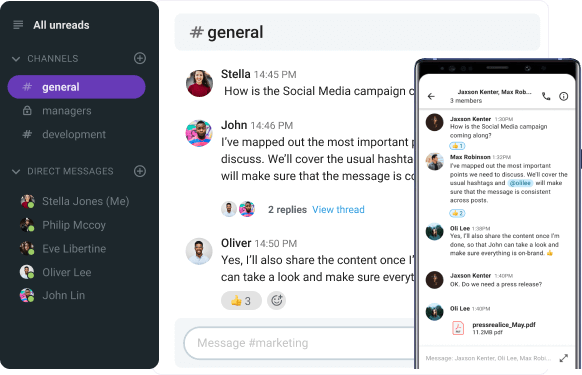To be successful, your team has to communicate. But, as it happens, effective communication doesn’t look the same for all teams.
While some prefer the “always-on,” real-time communication, others are more productive when they can communicate at their own pace.
But, can all communication tools facilitate exactly what your team needs?
Some, like Slack, are feature-packed, complex, and ever-present. Others, like Twist, are simpler and favor asynchronous communication that allows for deep work.
Lets see how these two compare, which teams might find them useful, and declare a winner in the Twist vs Slack battle.
Let’s begin!
Why trust us?
The apps we talk about are selected, tested, and written about by human reviewers who follow strict review and editorial guidelines. We pick solutions that are practical, purposeful, and can offer real value for the specific use case or business context we’re covering — while also being justified in their pricing. Our methodology is transparent, clear, and available to everyone:

Table of Contents
Twist vs Slack: A brief overview
The main difference between Twist and Slack is in their approach to communication.
Slack has plenty of features that were designed to keep you connected with your team — sometimes maybe even too connected. Team leads often report their teams are drowning in Slack notifications.
As someone who used this app extensively in the past and tried it out again for the sake of this review, I can confirm that Slack can become overwhelming quite quickly.
That’s not an issue Twist users have.
Twist has a more calm and relaxed approach, as it heavily favors asynchronous communication. You can reply to threads and check out what other people wrote in your own time.
However, is Twist too radically different from standard team communication apps?
Let’s compare the two and see.
Below, you’ll find a brief overview of both communication tools’ main features.
| Features | Twist | Slack |
|---|---|---|
| Pricing | – Free – Unlimited plan: $6 per user per month (billed annually) | – Free – Free trial of Pro or Business+ plans (30 days) – Pro plan: $7.25 per user per month (billed annually) – Business+ plan: $15 per user per month (billed annually) – Enterprise+ plan: Custom price |
| Free plan features | – Access to one month of comments and messages – Up to 500 members and 500 guests – Up to 5 integrations | – 90 days of access to past messages – One-on-one meetings – One-on-one messaging – Up to 10 integrations |
| Interface | User-friendly and clean | Complex and customizable |
| Communication | – Direct messages – Channels – Threads | – Direct messages – Channels – Threads – Lists, canvases, workflows – Huddles (voice and video calls) |
| Notifications | – DND – Customizable notifications – Email bundles of latest updates | – Pause notifications – Muting channels/DMs – Notification scheduling customization – VIP notifications |
| Search | Simple search (through messages and threads and within a specific time frame) | Advanced search (search through channels, messages, threads, and documents, and within a specific time frame) |
| File sharing and storage | – File uploads up to 100 MB – 100 MB size limit for attachments in emails sent to Twist – Free plan: 5 GB file storage per workspace – Unlimited plan: Unlimited file storage | – File uploads up to 1 GB – 90 days of message and file retention on the free plan – Unlimited access to files on the paid plans |
| Integrations | – Free plan: 5 integrations – Unlimited plan: Unlimited integrations | – Free plan: Up to 10 integrations – Paid plans: 2,600+ integrations |
| Support | – Email/Help Desk – FAQs/Forum | – Email/Help Desk – FAQs/Forum – 24/7 support available for Pro users and beyond |
| Security | Standard security | Advanced security |
If a simple overview isn’t enough, dive into our detailed Twist vs Slack analysis.
Twist vs Slack: Twist is cheaper, but Slack offers more bang for your buck
The good news is that both Twist and Slack have free and paid versions. So, you can take both apps for a test drive before committing to one of them — or, alternatively, use either one as a free tool.
I originally tried to test out both apps’ free versions, but Slack somewhat sabotaged me in my endeavor. As soon as I signed up with my test account, the app pushed me to try out their free trial for the first 30 days.
That gave me full access to all of Slack’s Pro plan features, which was great, but I had to wait to compare both apps’ free versions.
Finally, after a month, I can tell you that the free version of Slack gives you access to:
- 90 days of message history,
- Up to 10 integrations, and
- 1-on-1 calls and messages.
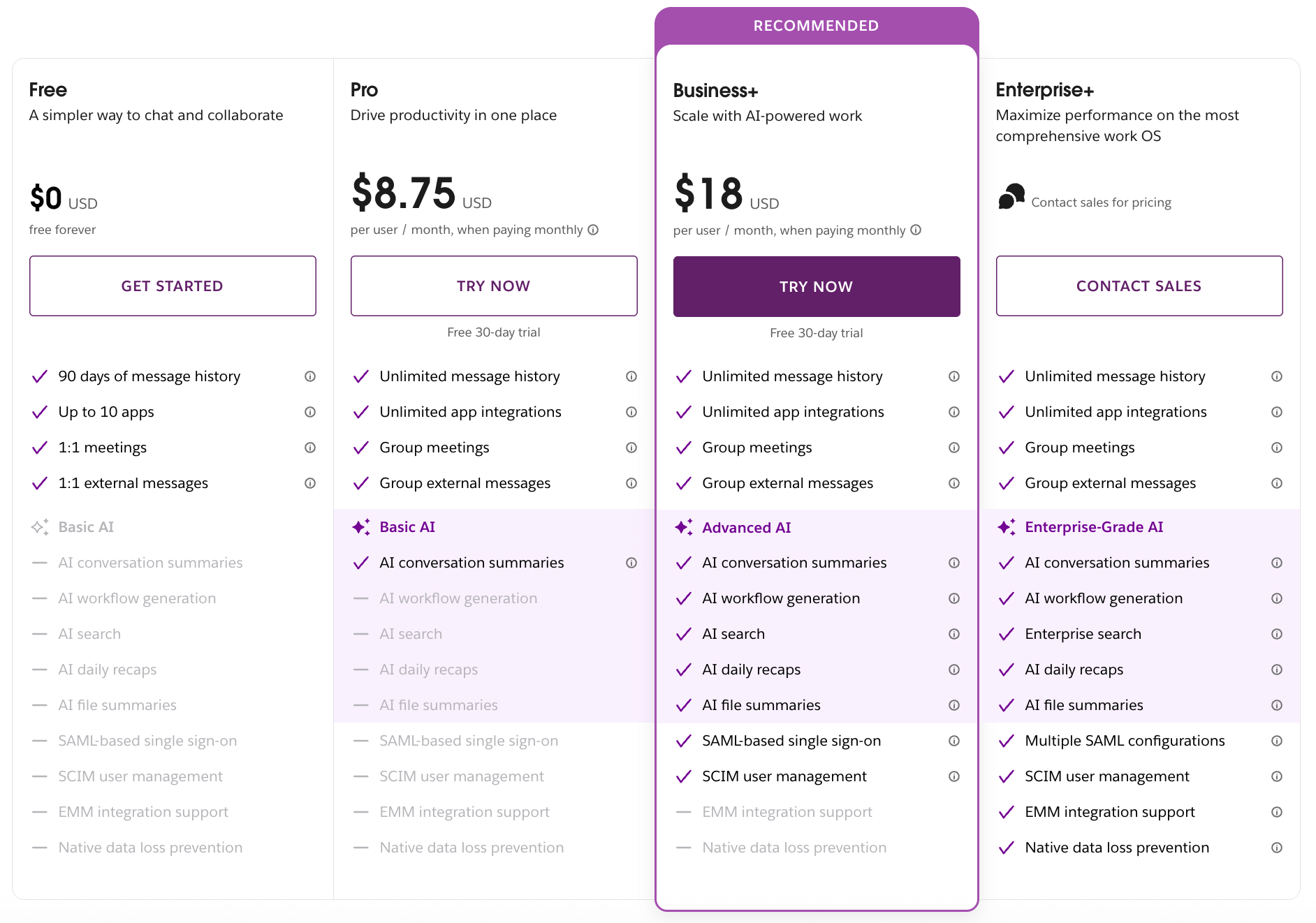
Meanwhile, the free version of Twist allows you:
- Access to one month of comments and messages,
- Up to 500 members and unlimited guests,
- 5 GB of storage space per user, and
- Up to 5 integrations.
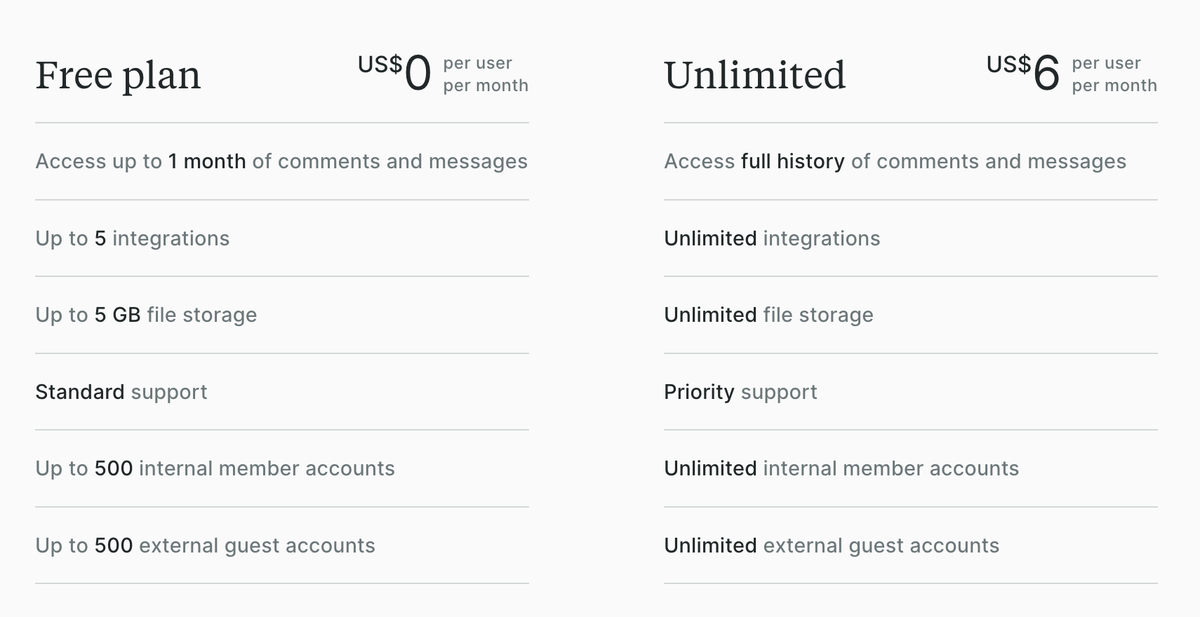
When it comes to paid plans, Twist’s offer is much more straightforward than Slack’s, as it only has one paid plan. It costs $6 per user per month (when billed annually) and gives you access to:
- A full history of comments or messages,
- Unlimited members,
- Unlimited integrations,
- Unlimited guests,
- Unlimited file storage, and
- Priority support.
Twist also offers localized payment, letting you pay for your subscription in 10 different currencies.
Slack, on the other hand, has a notoriously convoluted pricing that offers several tiers — which is a good feature for growing teams but can be confusing for first-timers who are trying to find the perfect plan for their company.
Slack’s cheapest plan costs $7.25 per user per month (when billed annually) and offers:
- Unlimited message history,
- Unlimited number of users,
- Unlimited app integrations,
- Group meetings (known as huddles),
- Group messages, and
- Basic AI functionality.
So, both apps have free plans, but they limit you in terms of the number of users and message history. It’s almost like their free plans just serve as a preview of what the apps can actually offer.
Still, Slack’s paid plan, although pricier, offers you more for your money.
Want access to your entire message history for free? Try Pumble
Twist vs Slack: Slack has a feature-rich interface, while Twist has a more streamlined look
Claiming to provide “a twist on collaborative communication”, Twist really does stand out on the market of team chat apps — even at first glance.
Unburdened by a slew of different feature shortcuts, Twist’s interface is lean and clean. It looks like a crossover between a group messaging app and an email inbox.
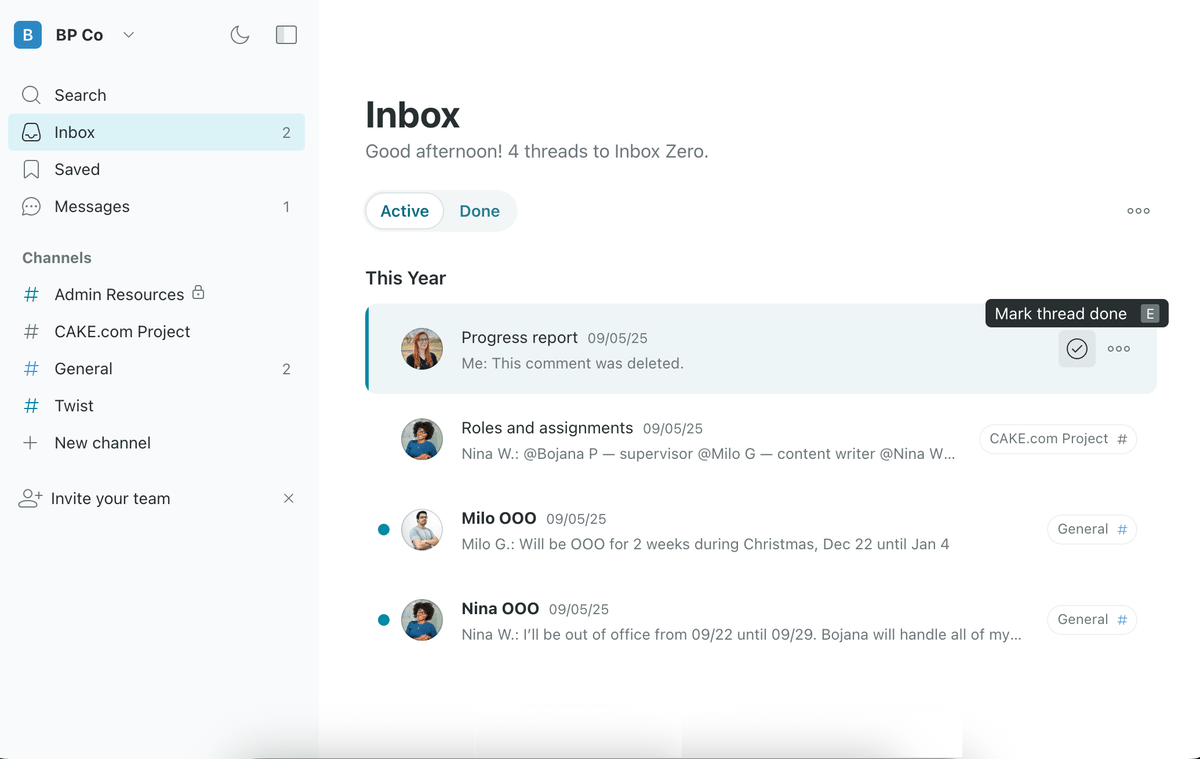
On the left-hand side, you have everything you need to communicate with your team — your inbox and all of your channels that contain various threads. Threads dominate the interface, allowing you to follow conversations easily. I’ll talk about threads in greater detail a bit later in the review.
When you’re finished interacting with a thread, you can mark it as done and Twist will move it in your inbox from the “Active” to the “Done” view.
And that’s it.
Twist is very committed to being an asynchronous communication app with as few distractions as possible. I’m guessing that the philosophy behind the brand led to it being so bare-bones in terms of both features and appearance.
If you like to tinker with your workspace in your team communication app, you’ll be a bit disappointed with Twist, as it only offers two themes — a light one and a dark one. This was a slight letdown for me, because I’m used to having a lot more options in Pumble, the business communication app I use on a daily basis.
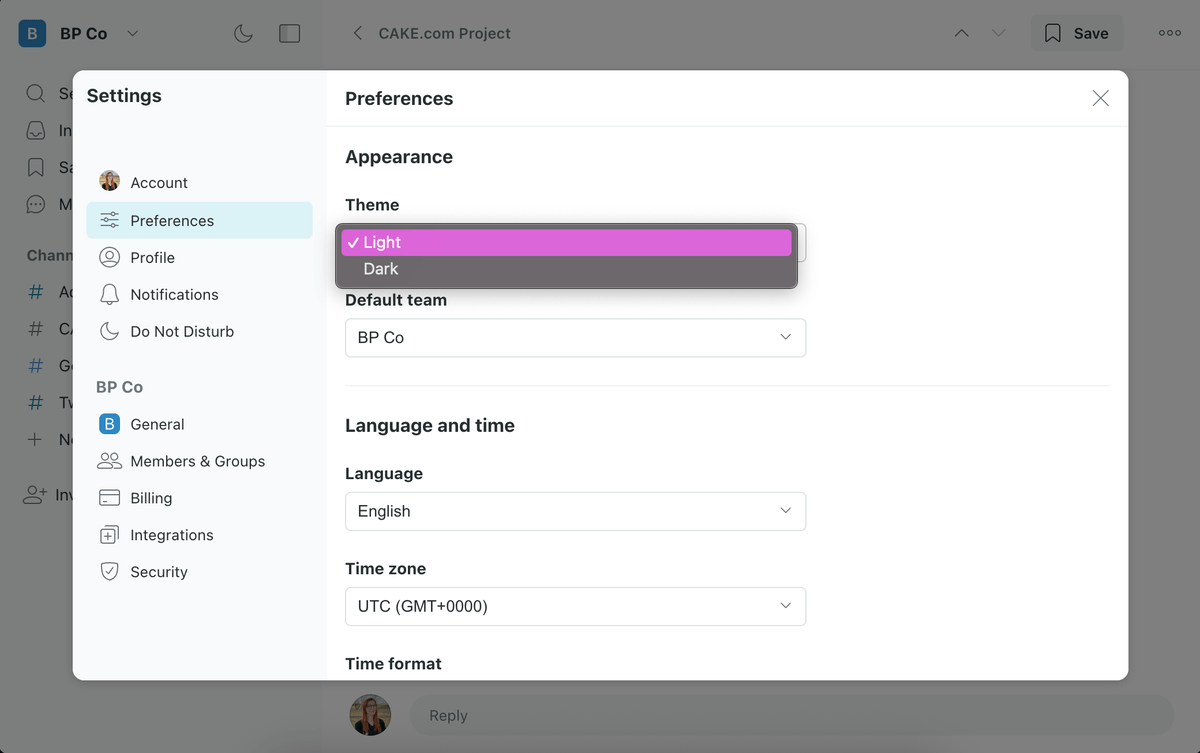
On the other end of the spectrum, we have Slack. It’s loud, busy, and with a customizable interface that’s begging for your attention with every square inch of your screen that you make available to it.
Offering features such as direct messages, channels, threads, canvases, and workflows — to name a few — Slack was clearly created to make you always available to your team.
While that’s not necessarily a bad thing, it’s a stark contrast to Twist’s “no distractions, deep work only” approach to team communication. Even their interfaces are completely different, as you can see.
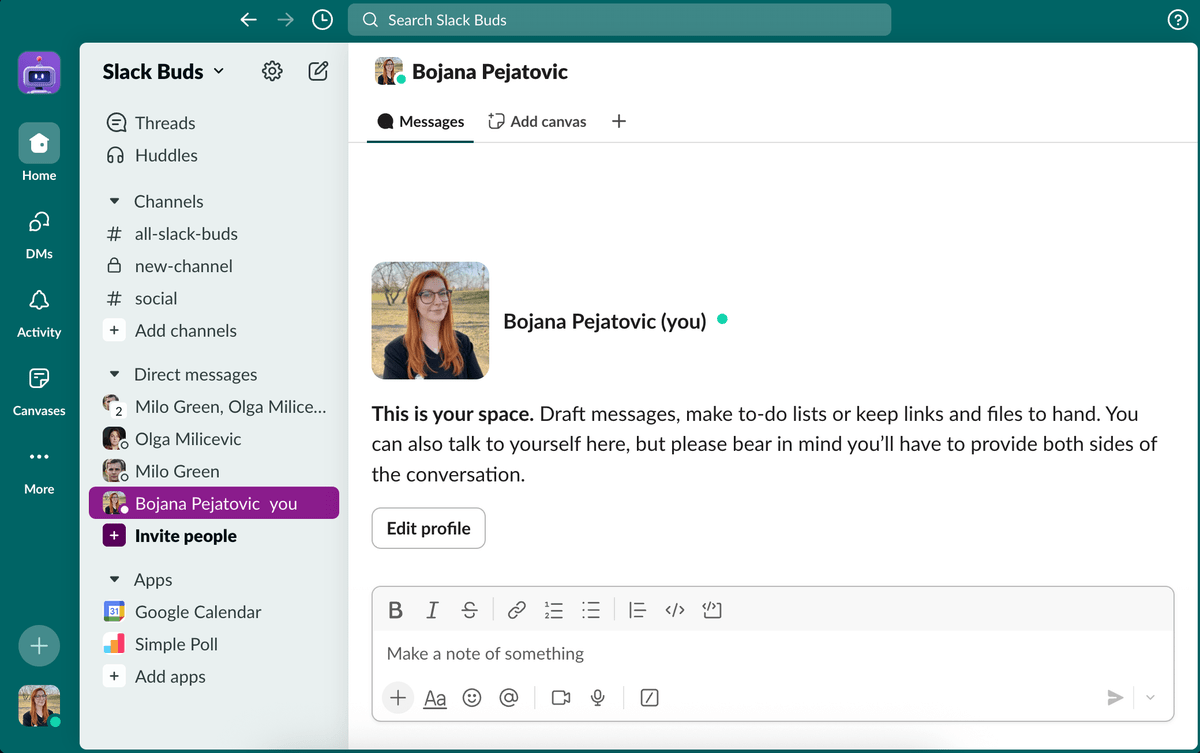
However, I do have to give credit where it’s due — Slack’s interface is exceptionally user-friendly. Everything has its own logical place, and it’s quite easy to navigate.
Still, using Slack to communicate with a fairly busy team of more than 5 people means you’ll get slammed with a tidal wave of notifications every work day.
As far as customization goes, Slack has Twist beat by a mile.
Offering both a light and a dark theme as well as a whole array of preset and custom color themes, Slack reigns supreme when it comes to personalizing the app’s appearance.
Aside from theme and color, you can also pick the font and the notification sounds.
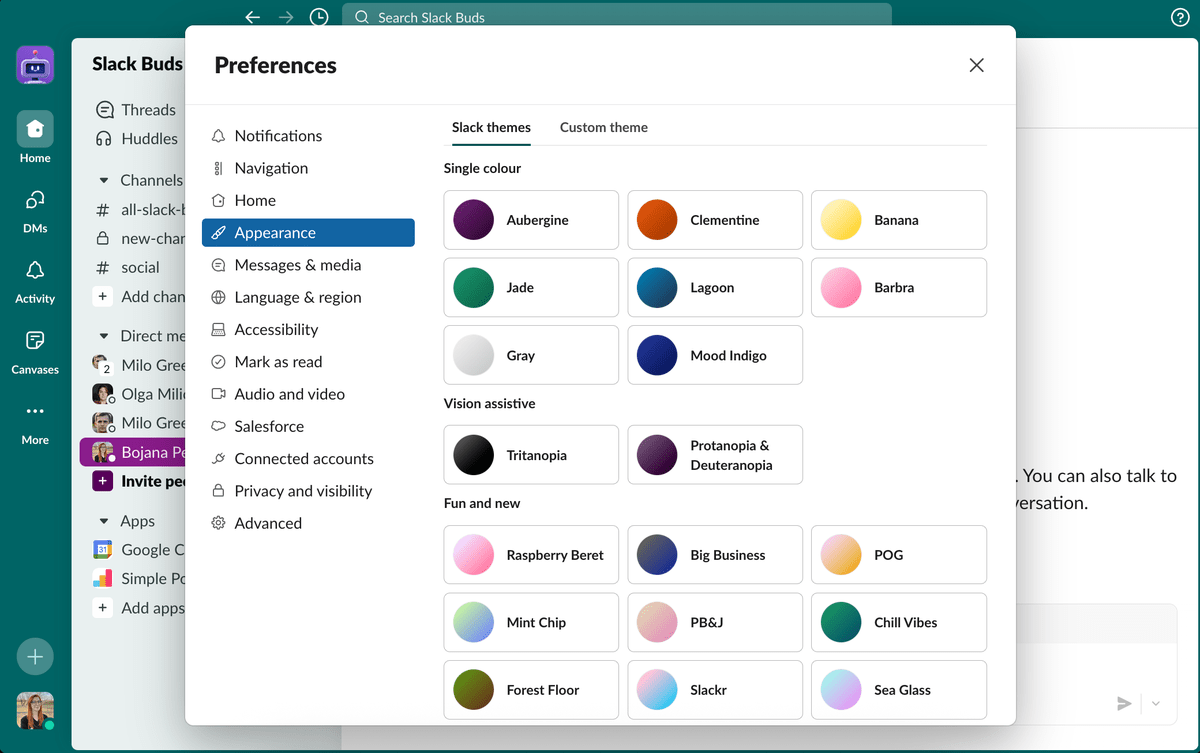
So, while Twist doesn’t offer any options for customization, some would say that Slack offers too many.
I spent hours tinkering with Slack’s theme options, finding the perfect shade of blue that I wanted — as if it mattered — and scrolling through fonts.
While fun, that side quest was a massive waste of time that kind of made me yearn for a middle-ground solution.
Customize your workspace without becoming overwhelmed — try Pumble
Twist vs Slack: Twist offers a few high-quality features, while Slack gives a variety of options
Now that we’ve gotten the pricing and UI out of the way, we can move onto the most important thing — the communication options.
Here’s where the situation gets a bit complicated.
Both Twist and Slack offer high-quality communication options. However, their features are in line with their vastly different approaches to communication. Whether you’ll prefer one or the other depends on your and your teams’ needs and habits.
Both apps have basic options necessary for team communication and collaboration:
- One-on-one conversations,
- Public and private dedicated channels for group conversations,
- Threads for better organization of communication, and
- The ability to turn messages into tasks (through Lists in Slack and a Todoist integration in Twist).
However, Slack offers more features on top of those I listed above — even on the free plan.
Twist’s communication features
Twist offers several communication features:
- Channels that contain various topic- or project-specific threads,
- An inbox that contains all updates from the threads the user is a part of, and
- Messages that allow users to engage in one-on-one communication.
So, using Twist entails creating channels and then starting threads within those channels.
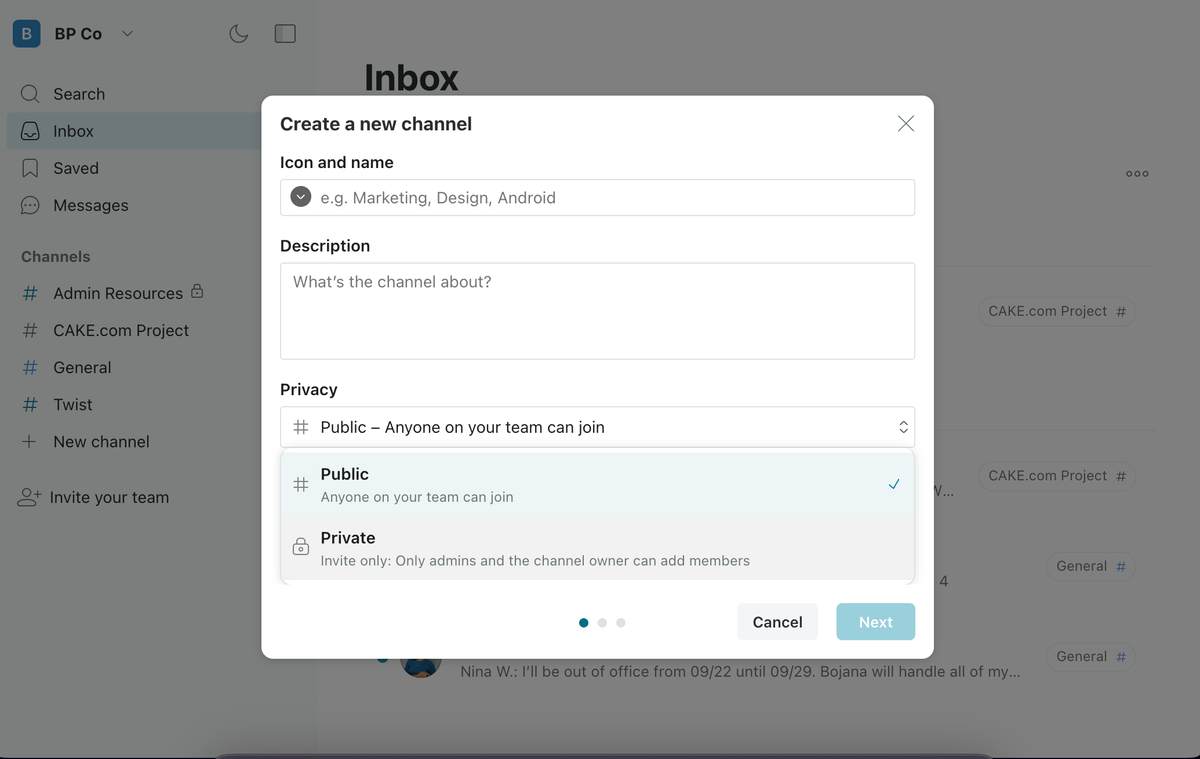
Threads are the core functionality of Twist — that’s where you’ll communicate, share updates, and discuss topics.
You can start as many threads as you want within a channel, which makes organizing communication a breeze.
Since Twist is big on users doing things on their own schedule, even if you get interrupted midway through making a thread, Twist will save a draft for you, and you’ll be able to come back to it whenever you want.
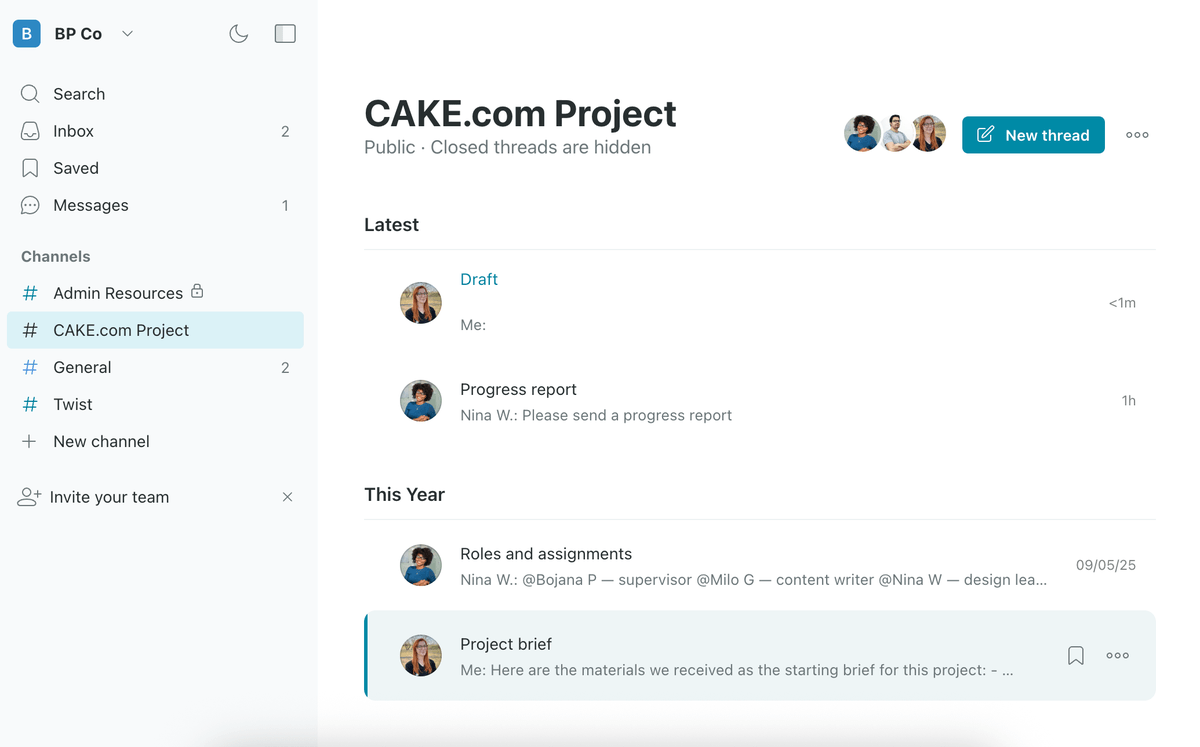
Every time a thread gets updated, all users who are a part of that thread will get a notification in their inbox. However, I quickly learned (and loved) that users won’t get a notification for every new message — just one notification that there are changes in the thread.
You’ll find all updates in your inbox, which has two different views — the “Active” view and the “Done” view.
The “Active” view shows you all the updates in all the threads that you’re a part of. You can mark each thread as “done” after reading it. This will automatically move it into the “Done” section.
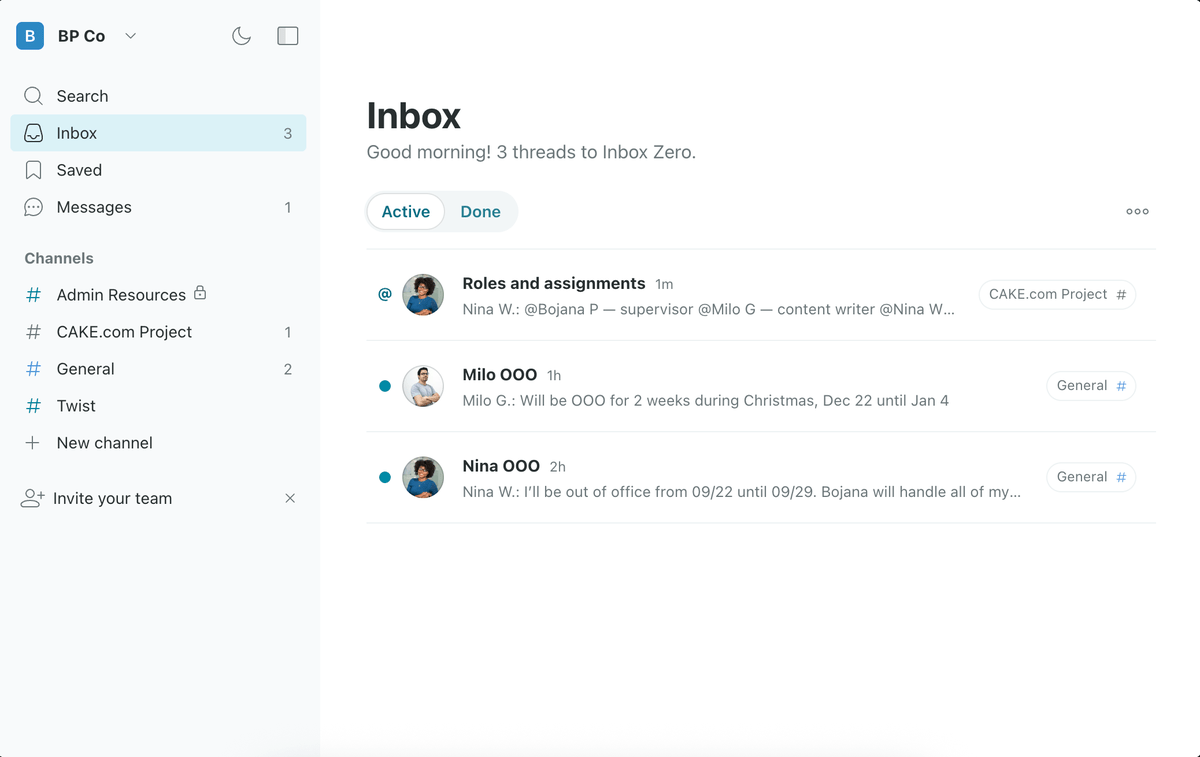
Twist also offers its users the option to directly message anyone on their team.
However, direct messaging isn’t a preferred mode of communication on Twist because it doesn’t allow for deep work as much as threaded conversations do. That’s why you’ll get a warning every time you try to send a direct message.
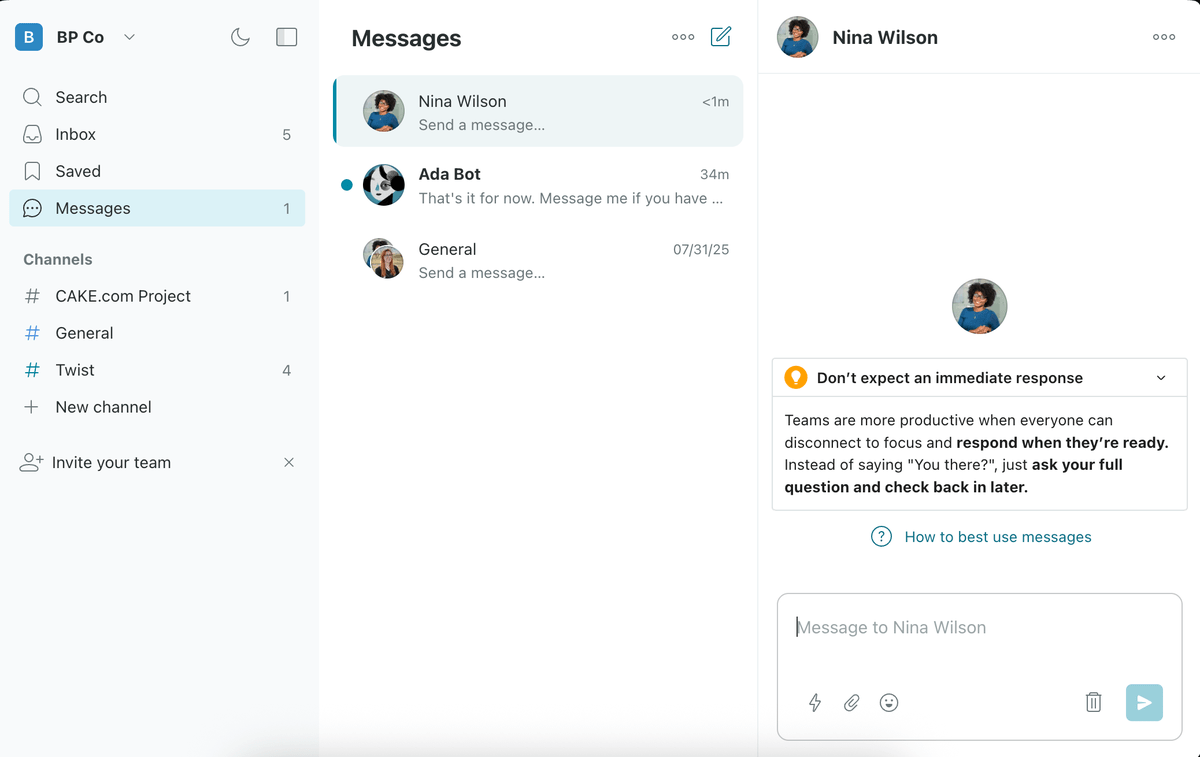
Overall, Twist has well-developed features that suit teams that don’t need constant, real-time communication. Other features, like video conferencing, for example, require the use of third-party apps.
Although this is completely in line with their philosophy, I do wish there was an easier way to facilitate real-time communication in Twist, when needed.
Need both asynchronous and real-time communication features? Try Pumble
Slack’s communication features
Slack’s core functionalities include:
- Channels for group conversations,
- Direct messages for one-on-one interactions,
- Threads for better communication organization,
- Huddles for one-on-one or group video conferencing (group huddles are only available on paid plans),
- Voice and video messages for quick and effective communication, and
- Lists, Workflows, and Canvases for brainstorming and group collaboration.
All of these features can be found on the left-hand side of your screen.
When you join Slack, you’ll have access to two pre-made channels (#general and #social), and, from then on, you can easily create your own.
When creating a channel, you’ll have the option to pick the type of channel you want to create — there’s a variety of templates at your disposal, no matter the plan you’re on.
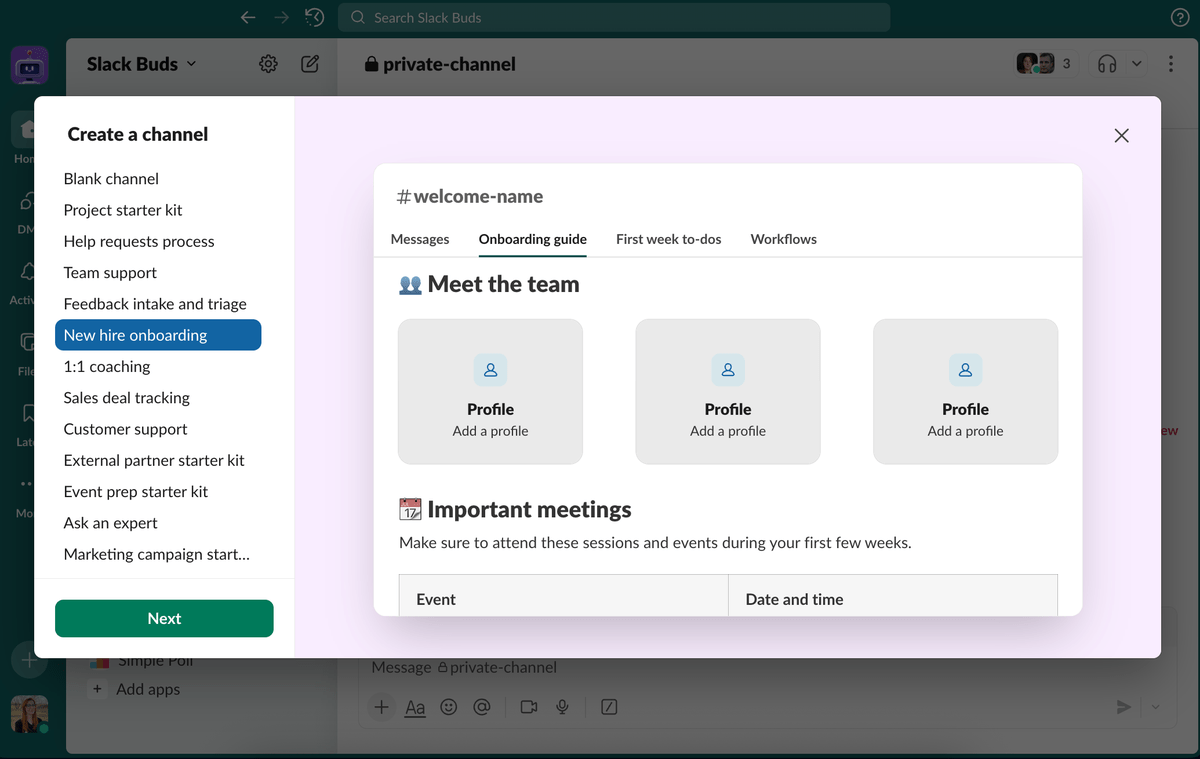
I like this feature because it cuts down on prep-time. For example, the template for a channel with a new hire includes an outline where you can add all the relevant documents and resources the new employee might need.
Huddles, Slack’s video conferencing solution, are a well-developed feature that makes Slack ideal for teams that have an “always-on” mentality.
Free users can start and join one-on-one huddles that can last up to 30 minutes, while paid users don’t have those limitations — they can start and join group huddles without a time limit.
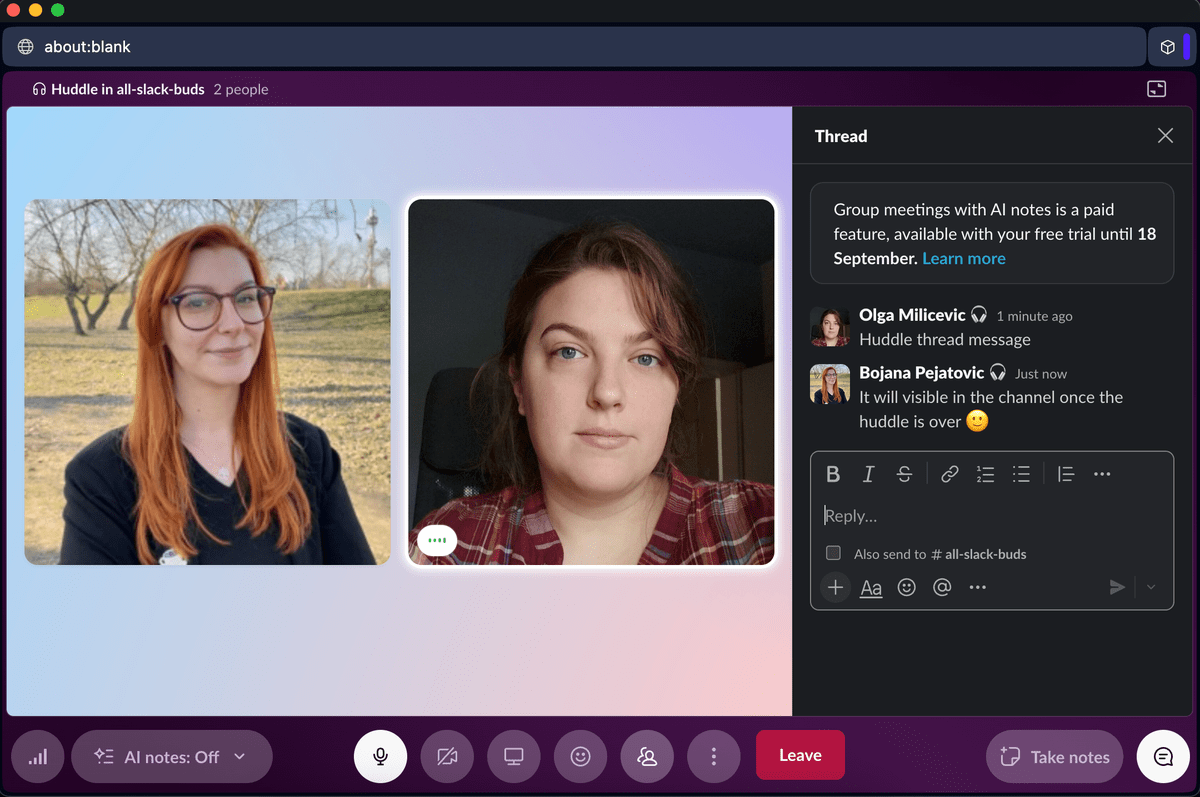
One of the features that I like the most is that all messages exchanged during a huddle are saved in the thread below the huddle. That means there’s less chance of losing important information that was shared during face-to-face communication.
What’s more, it also allows for conversations to be revisited or continued even long after a huddle is over — as you can see in the image below.
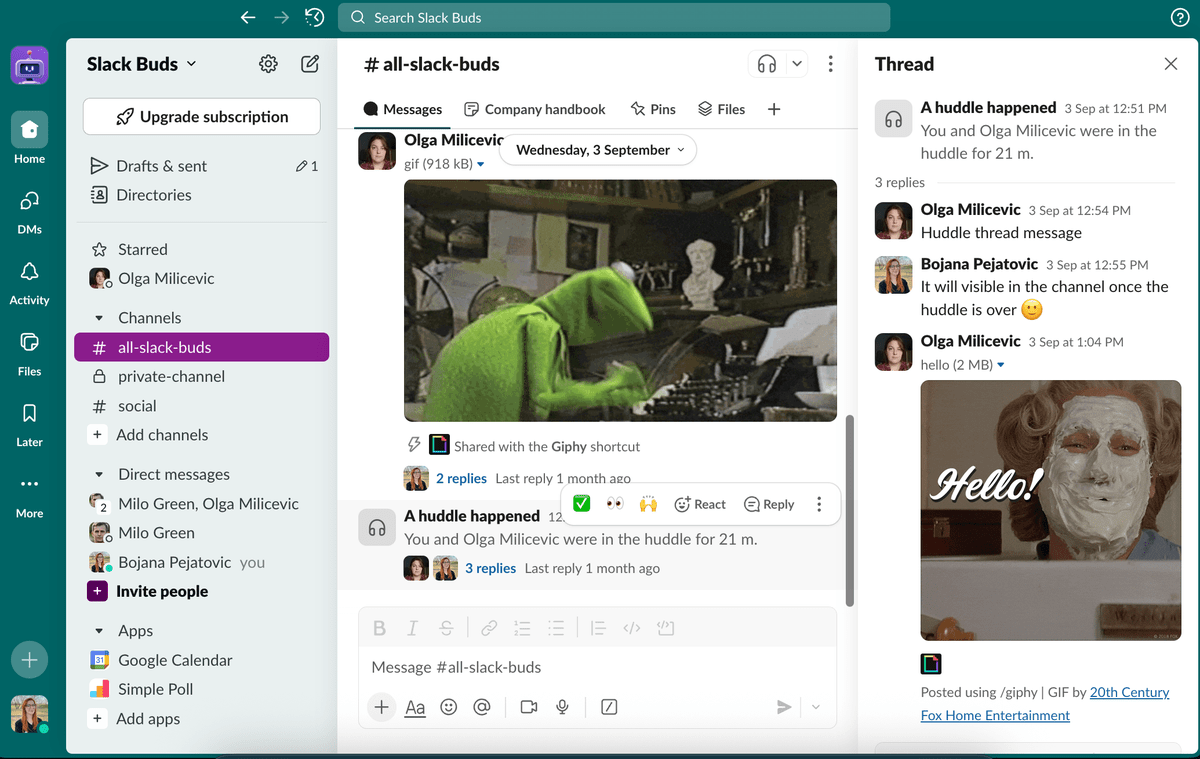
Of course, this only matters if you’re a paid user. Remember, free Slack users lose access to their message history older than 90 days.
Never lose important information or files — try Pumble
Slack’s paid users can also enjoy another huddle-related feature — the AI-powered meeting transcripts. Slack’s AI bot will transcribe your meeting for you and send you the notes a couple of minutes after the meeting is finished.
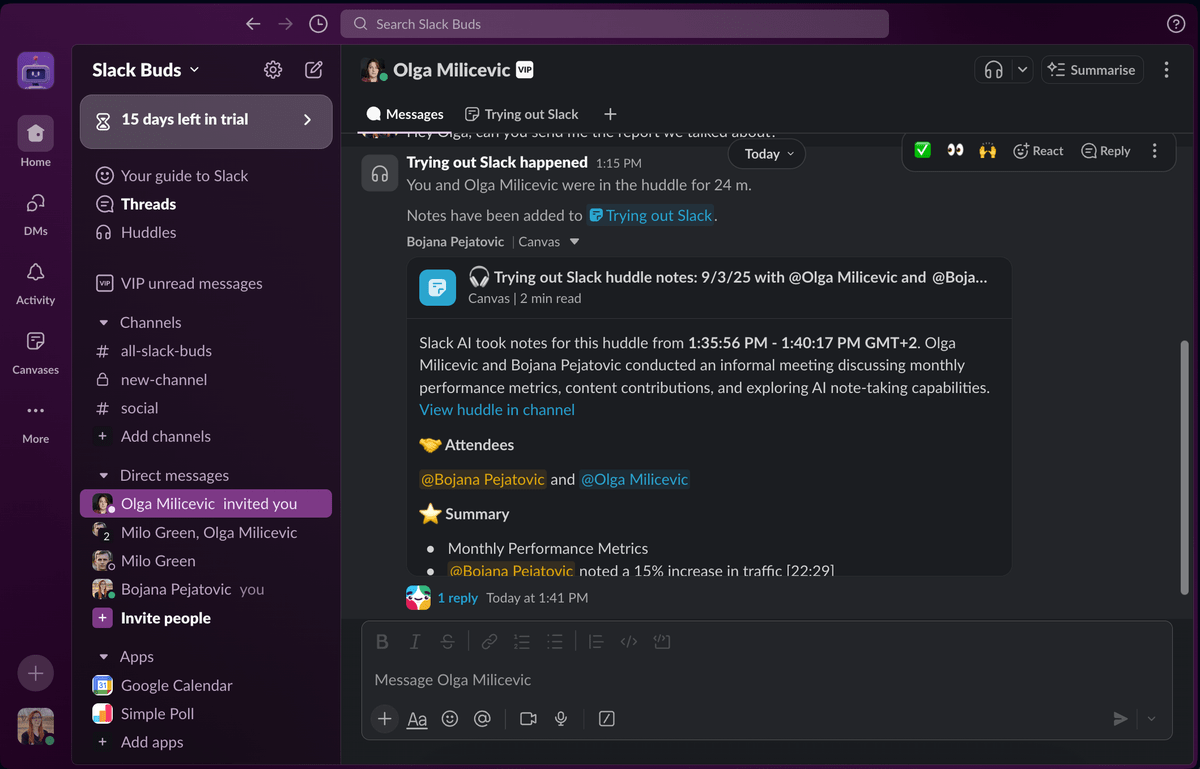
Don’t expect miracles, though — the AI bot sometimes has trouble keeping track of who said what. What’s more, as far as I noticed, it has a very difficult time with accents, which isn’t great news for international teams.
Twist vs Slack: Twist sends fewer notifications, while Slack overwhelms you
Twist strives to notify you less and improve communication by making it asynchronous and more relaxed.
As mentioned, you’ll only get one notification for every updated thread or direct message – no matter how many individual messages were added to the tread or DM.
I really enjoyed that feature, since it basically made notification fatigue impossible. If you’re part of 5 threads, you can get 5 notifications in total — that’s it. And, as a bonus, the notifications don’t make any sounds, and there are no pop-up bubbles that come up on your screen, distracting you from your work.
You can further customize your notifications and cut down on distractions by choosing what you get notified about.
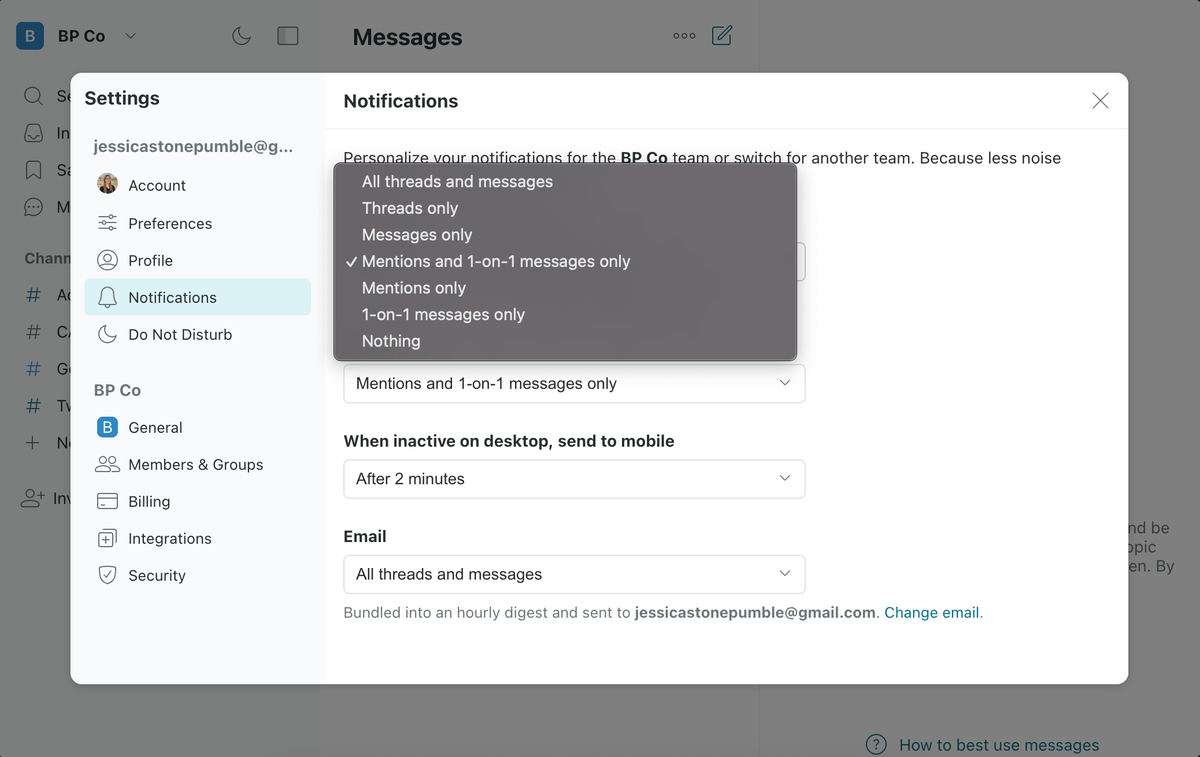
Twist also allows you to switch to a Do Not Disturb mode and set a weekly schedule for your notifications.
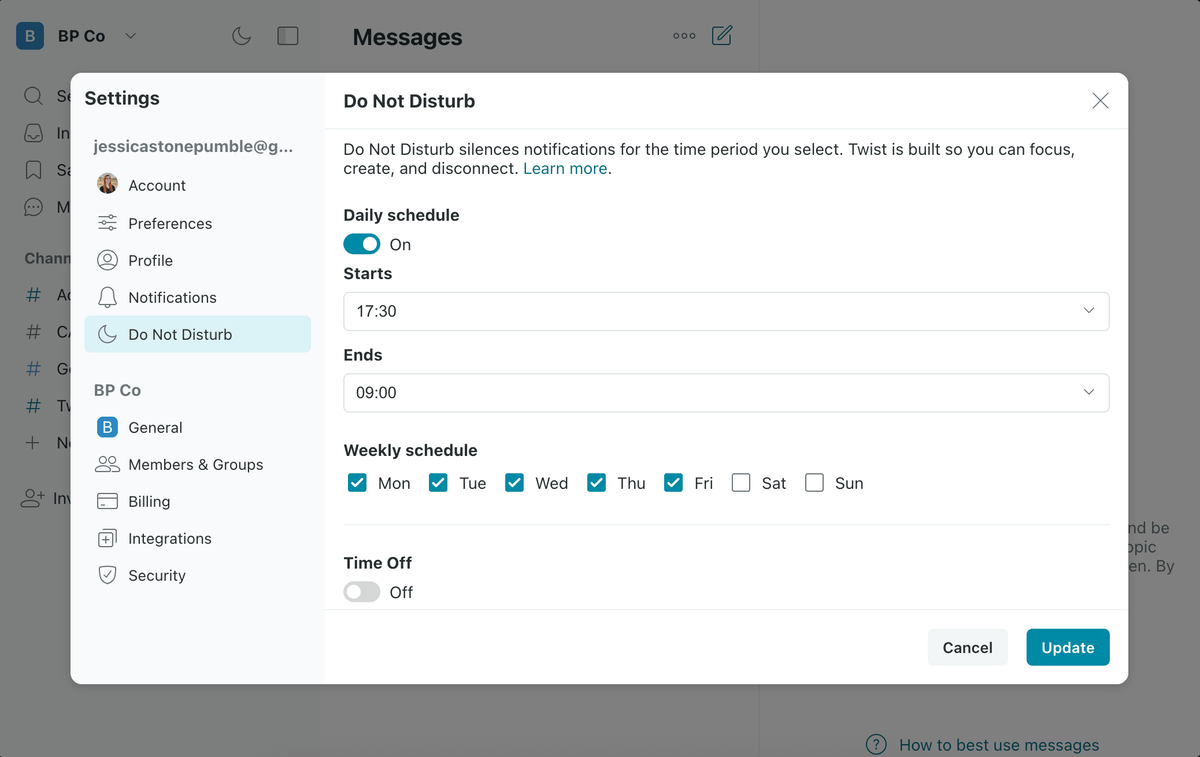
Unlike Twist, Slack will notify you about all new messages — and I do mean all.
The activity tab on the left-hand side of the screen is where you’ll find all the notifications about all the changes made in any channel, thread, huddle, or DM that you’re a part of.
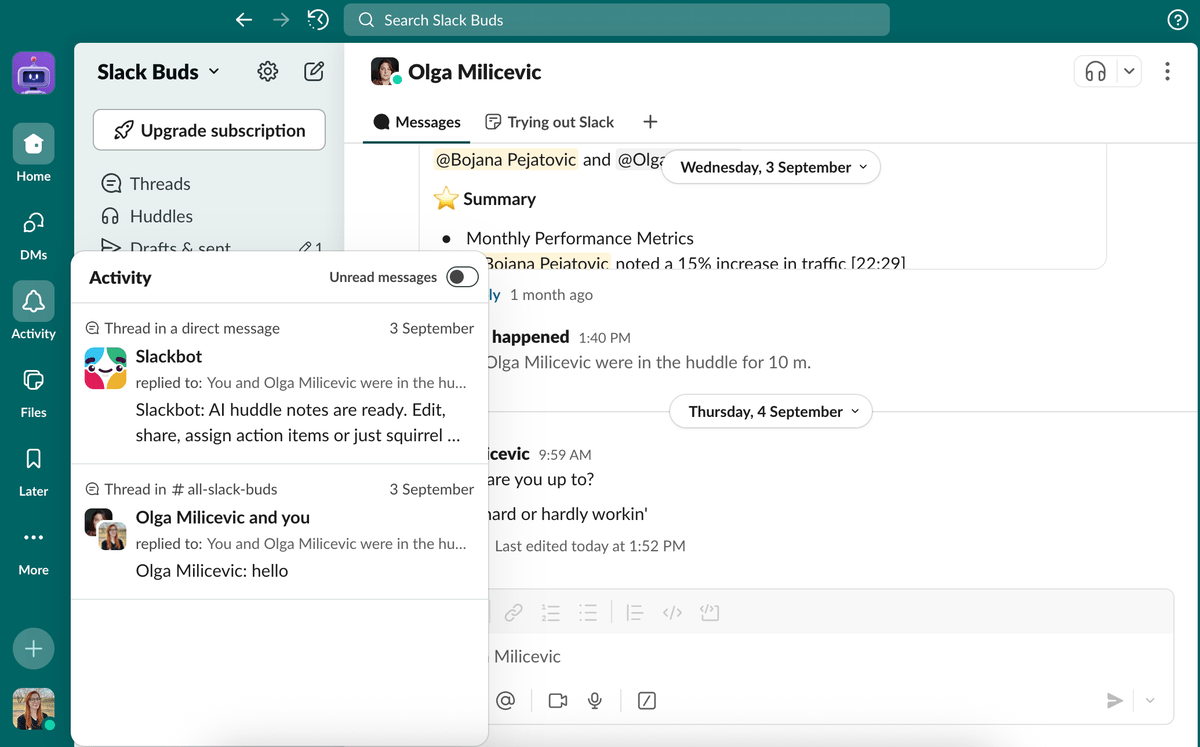
However, you can also find notifications in your unread section as well as on your channel list. So, there’s a chance you will get notified multiple times about one update or message.
Luckily, Slack offers an extensive notification settings menu as well as shortcuts that let you quickly pause notification or set yourself as Away.
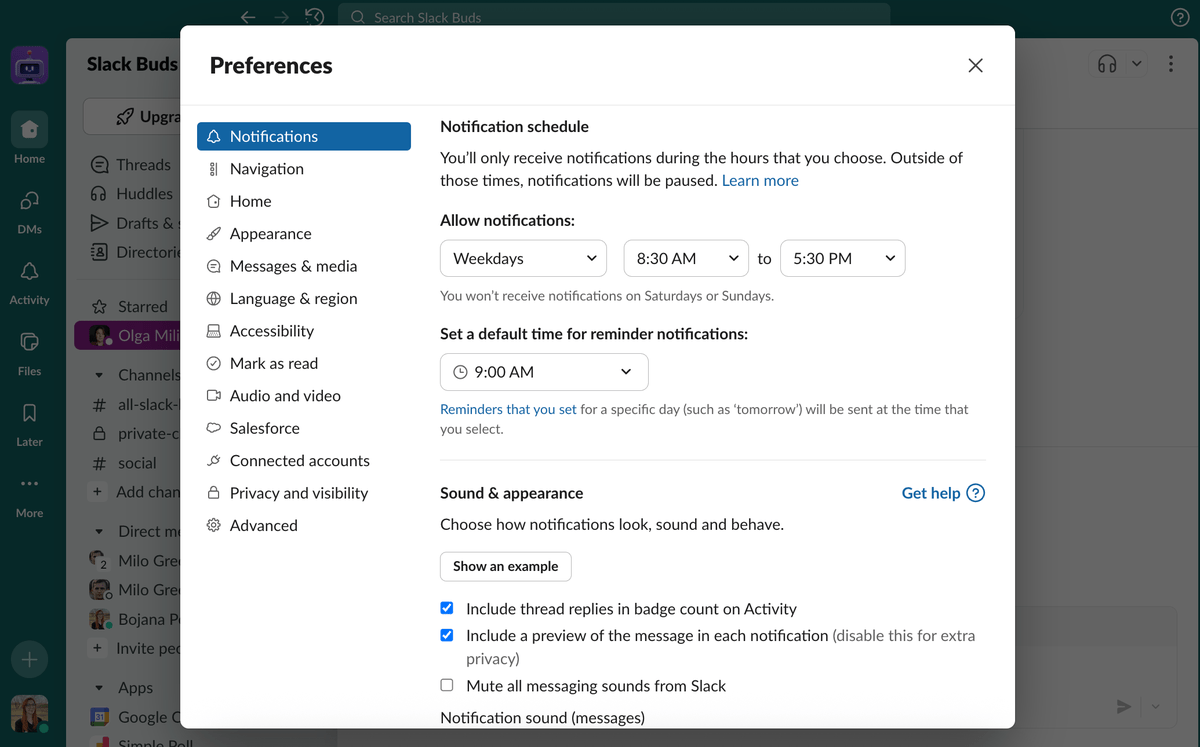
Just like Twist, Slack has a Do Not Disturb mode that lets you shut down all notifications. The only exception would be notification from VIP users — if you marked any of your teammates as VIP.
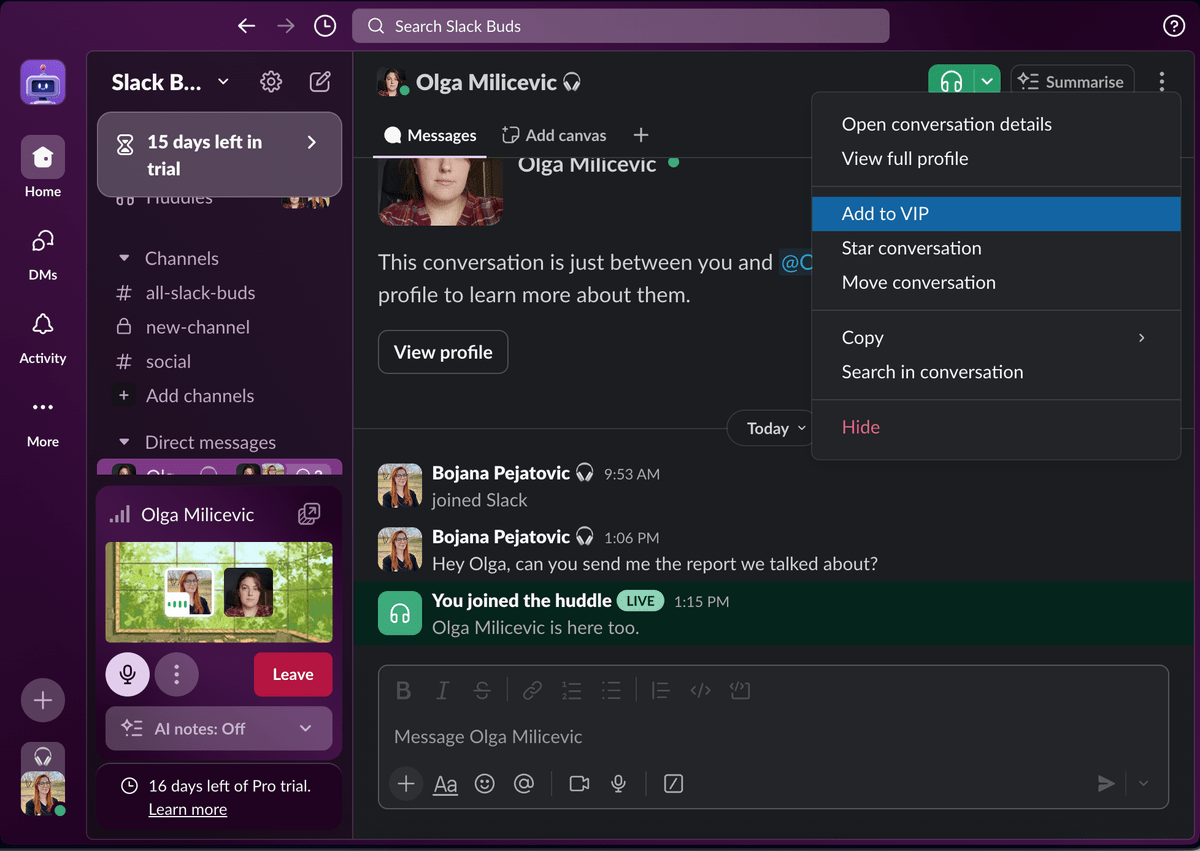
All things considered, Slack is a more customizable business messaging platform when it comes to notifications, but Twist really allows its users to unplug.
Create your own notification schedule on Pumble
Twist vs Slack: Slack has slightly better search options, but both apps limit free users
If there’s one thing that will make me drop an app like a hot potato, it’s a poorly designed search feature.
Luckily, both Twist and Slack offer solid search options.
In Twist, you can search your entire workspace and filter your search to include:
- Message participants,
- Thread titles,
- Channel names,
- DMs, and
- Time windows.
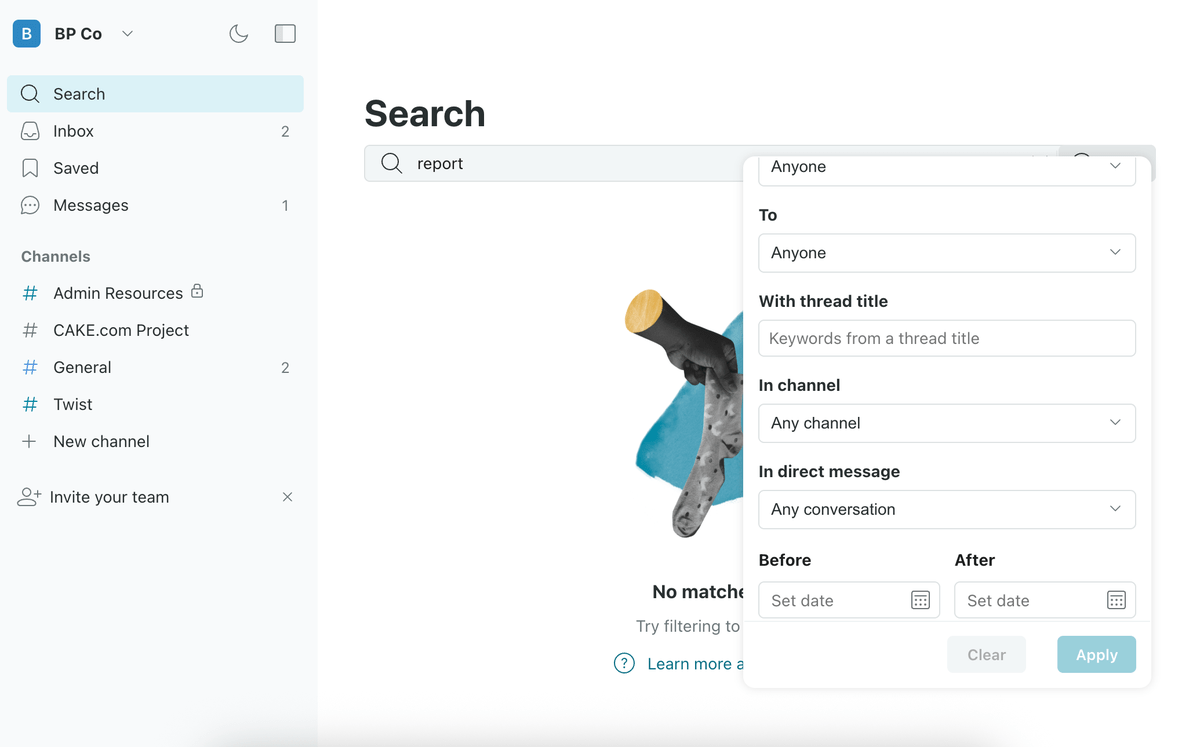
I like that you can put in keywords from thread titles and filter your search according to that — you don’t have to know the full title to be able to find the information you need.
However, if you’re a free user, you can only search through the last month of messages. So, no matter how well-designed it might be, the search feature in Twist can be severely limited.
Things aren’t any better on Slack.
Although Slack lets you search for messages, files, channels, and people, and filter your search in various ways, the app limits its free users to just 90 days of message and file history.
So, if you’re a free user and you need that report from 4 months ago, you better hope you saved it on your computer, because Slack will not give it to you.
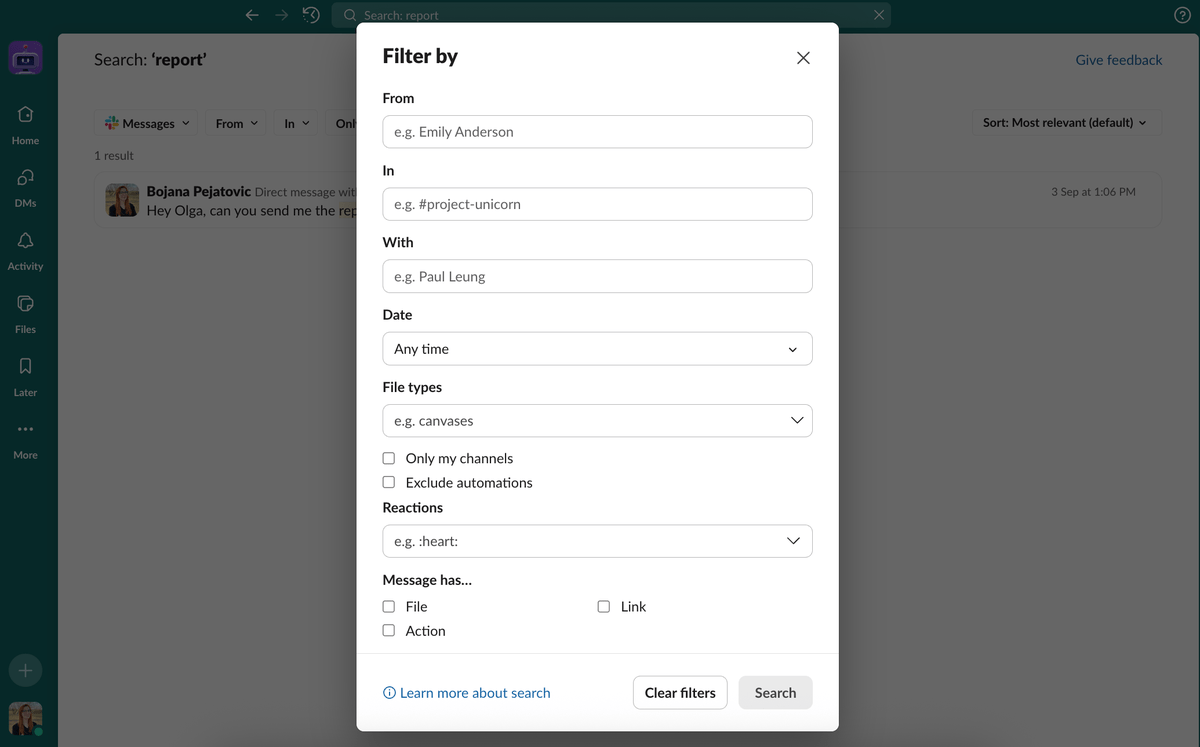
I will say that Slack offers slightly more advanced filters than Twist. Still, both apps have severe limitations for free users that can render the quality of the search feature irrelevant.
Unlimited message history, even on the free plan — try Pumble
Twist vs Slack: Both apps limit storage for free users (but not for paid users)
Messaging apps have become the digital HQs of companies long ago. So, it’s only natural that being able to share files — and large files, to boot — without fear of running out of space is one of the deciding factors when picking a communication app.
Twist offers solid file sharing options, as you can share files in threads, direct messages, as well as in comments to a thread.
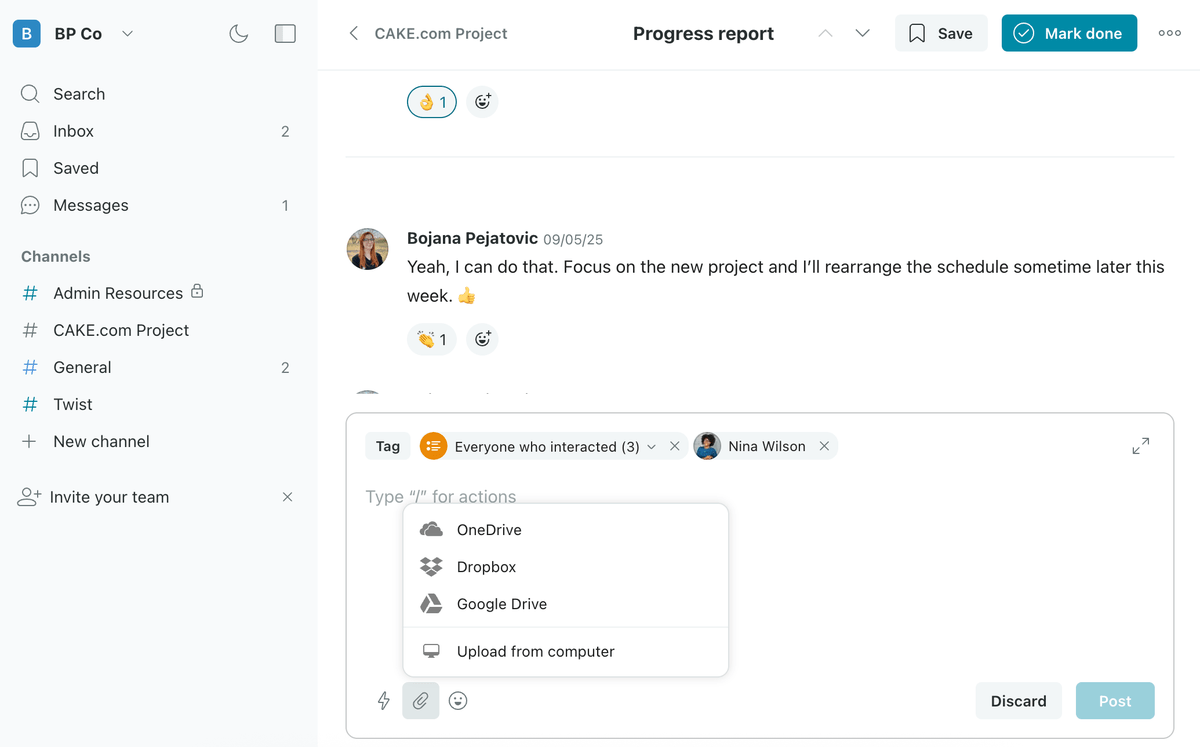
However, Twist does limit its free users to 5 GB of storage space.
What’s more, there’s also a file size limit for attachments of just 100 MB. This goes both for files shared directly on Twist and for attachments in emails sent to Twist.
If this limit doesn’t work for you, I’ll have to disappoint you by telling you there’s no way around it, as both the free and the paid plan have this limitation.
Twist is more generous when it comes to storage space on paid plans, though — there’s no limit for paying users.
Slack allows its users to share files in DMs, channels, and threads — but not during huddles. It also offers a more generous file size limit of 1 GB per file.
This, in my opinion, makes it far superior, especially for teams that often share large media files. There’s also a handy option to share recently received or sent files.
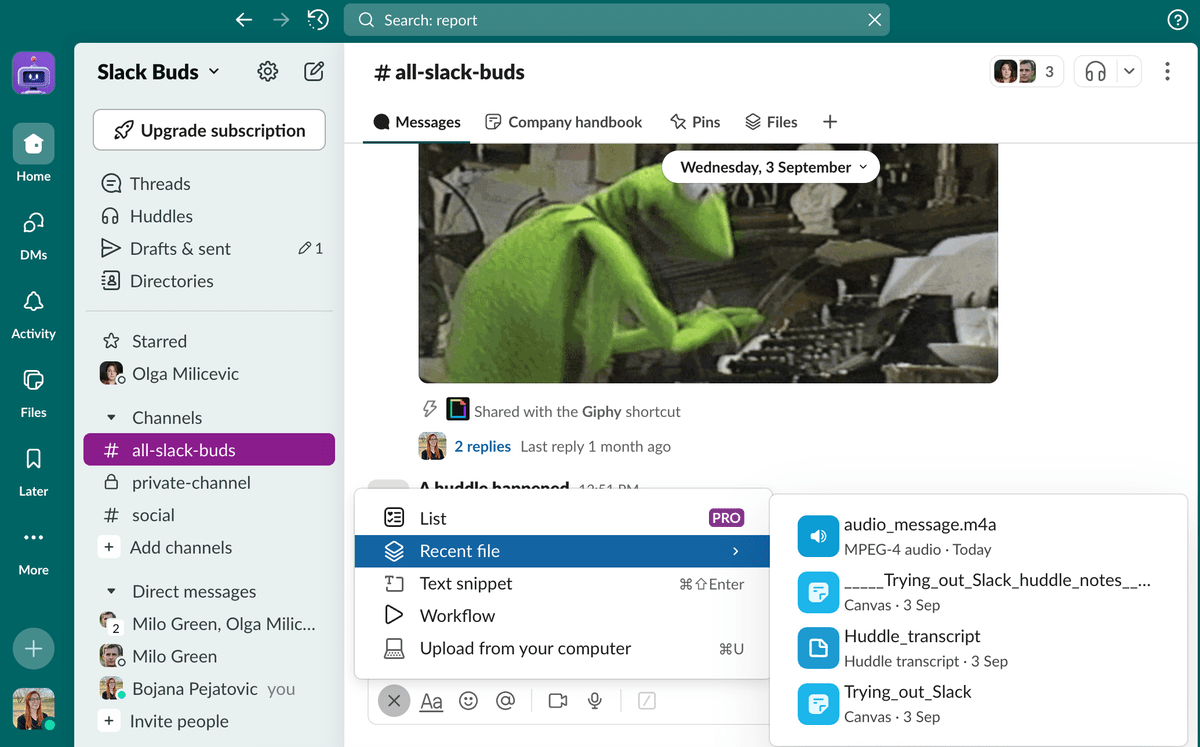
When it comes to the storage limit, Slack used to offer free users 5 GB of storage space, while paying customers had 10 GB, 20 GB, and 1 TB of space at their disposal.
However, there’s no information about storage space on Slack’s website anymore — all it says is that paid plans include unlimited storage. Still, I can’t really confirm it, and there was no way for me to check the remaining storage space in my workspace — both on the free trial and on the free plan.
But, more importantly, both Slack and Twist fail on another front — at least for me.
When I’m picking a team chat app, being able to access all the files and messages shared on the app is quite high on my list of must-haves. But both Twist and Slack have severe limits for their free users.
As mentioned, Slack limits the message and file history to just 90 days for its free users. What’s more, it permanently deletes messages after a year. So, even if you switch to a paid subscription, there’s a chance you already lost some of your data and files (if you’ve been a free user for more than a year).
The situation is even worse on Twist, as free users can access only up to a month of shared comments and messages.
That means that neither Slack nor Twist would be able to serve as a digital HQ for free users. You’d have to pay for that perk.
Get 10 GB of storage + unlimited message history for free with Pumble
Twist vs Slack: Slack offers more integrations
Third-party integrations are useful for collaboration with other apps and tools and enable a better workflow. So, a good team communication app should have a solid selection of apps you can integrate into it.
When it comes to this area, Slack has Twist beat. It offers 2,600+ integrations that you can add directly through your chat by using the Slash command and selecting the Browse apps option.
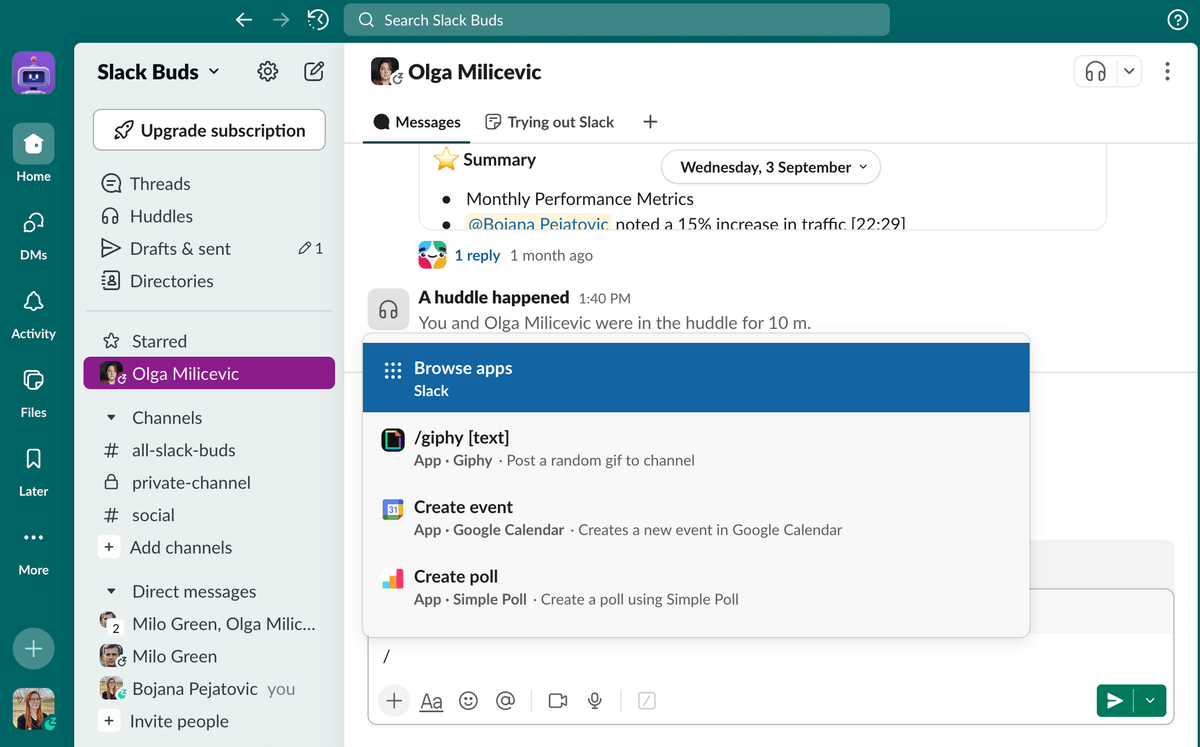
Twist has a more modest selection — although it still offers a solid number of apps you can integrate it with. Adding apps is almost as easy as it is on Slack. All you have to do is select the “Add integrations” options within the selection menu in a channel.
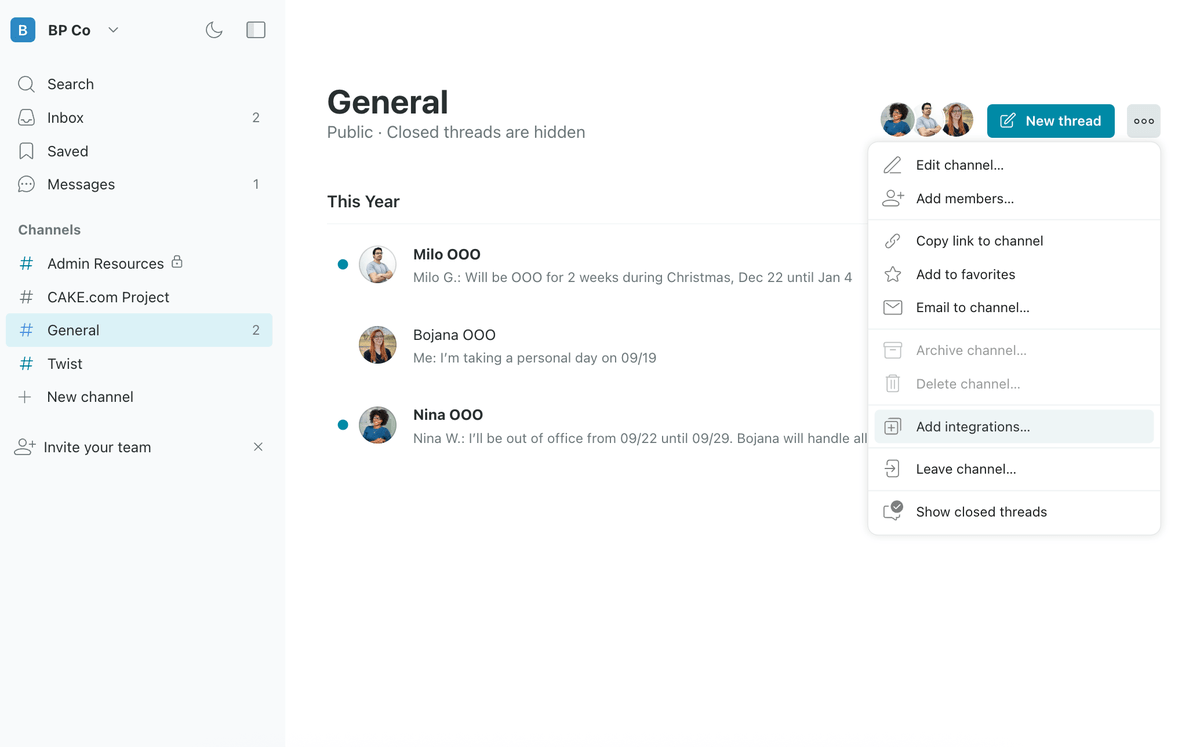
Most importantly, since Twist is a product made by Doist, it integrates well with another popular app from the same company — Todoist.
Aside from Todoist, Twist integrates with another 33 apps, one of which is Zapier, an app that connects different web applications and services to automate tasks and streamline workflows.
It’s important to note, of course, that both Slack and Twist limit the number of integrations on the free plan to 10 and 5 apps, respectively. So, unless you cough up money for a subscription every month, you’ll only get a taste of their selection of integrations.
Build your own integrations in Pumble
Twist vs Slack: Both apps offer solid support, but Slack’s is more extensive
People don’t realize how important customer support is until they need it. But, by then, it’s probably too late — you get what you get.
That’s why it’s vital that you assess what a business messaging app offers in terms of support before you start building your team’s digital HQ on it.
Both Twist and Slack offer similar support to their free users — a knowledge database they can search through.
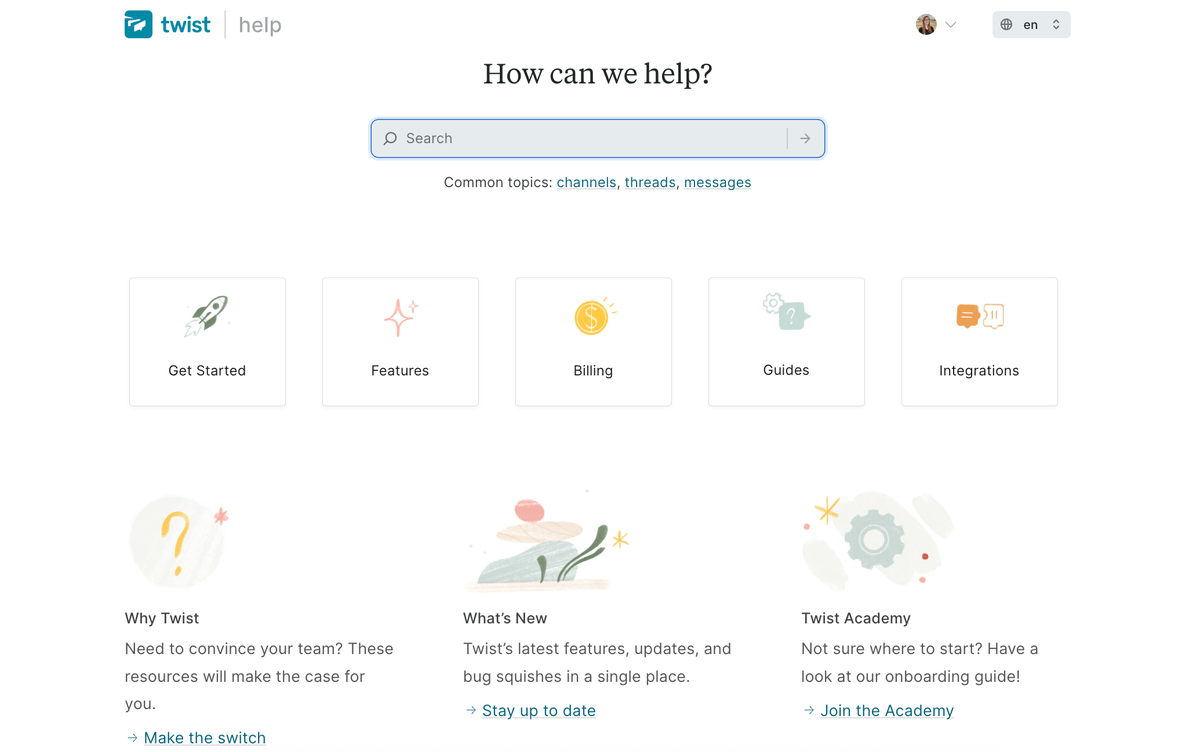
These help centers are helpful for users who encounter common problems — ones that can be resolved without having to contact a support agent.
That’s good because free users can’t contact a support agent on either app — that’s reserved for paying users. What’s more, neither app offers phone support, but they have support teams available to help users via email.
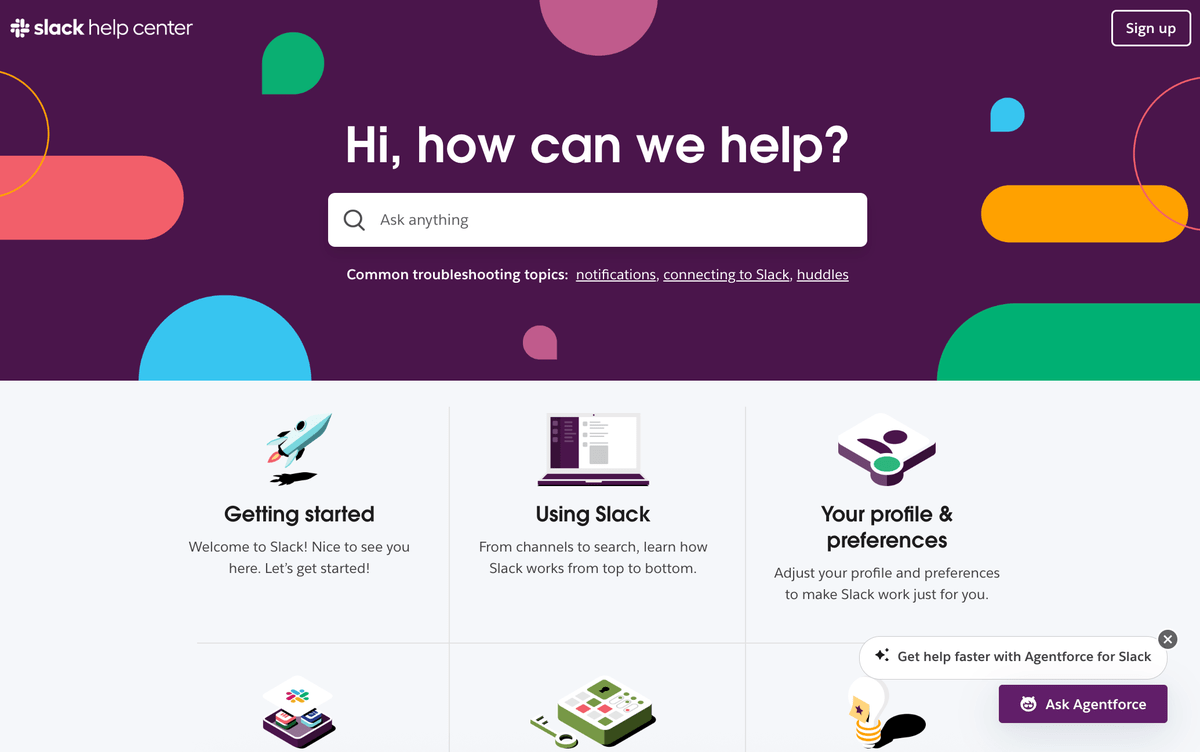
Twist provides paying users priority support via email, but there’s no mention of how long the wait time might be. Meanwhile, Slack offers dedicated support to users on their Enterprise+ plan, while Business+ users can expect a response within 4 hours.
Twist vs Slack: Slack offers superior security features
Finally, when picking a business messaging tool, it’s always good to go with the one that has independent verification of security and privacy, as well as compliance controls.
Since Slack is a titan in its field, it’s safe to say it takes security quite seriously.
In addition to data encryption in transit and at rest and the standard industry certifications like ISO/IEC and SOC, Slack also participates in the following frameworks:
- FedRAMP (Federal Risk and Authorization Management Program),
- FINRA (Financial Industry Regulatory Authority), and
- HIPAA (Health Insurance Portability and Accountability Act) — among others.
Although Twist also offers data encryption in transit and at rest and is compliant with GDPR, Slack is audited against more compliance and assurance programs, including SOC2, SOC3, and ISO/IEC.
Need a secure messaging app? Give Pumble a try
Final verdict: Twist allows more focus, while Slack offers more features
We started this review with a few questions — is Twist a good Slack alternative, and which of the two apps is better?
The answer, as you probably realized by now, is — it depends. Your and your team’s communication needs and habits are the most vital determining factor.
So, for example, you might find Twist to be an excellent choice if your team:
- Is small,
- Doesn’t need constant real-time communication,
- Engages in a lot of deep work,
- Wants to limit distractions,
- Prioritizes asynchronous communication, and
- Is ready to sacrifice advanced features for the sake of focus.
At the same time, you might find Slack to be the better of the two if your team:
- Works in a dynamic setting that requires an “always-on” approach,
- Places emphasis on immediate communication,
- Requires various modes of communication, and
- Needs advanced collaboration features built into the app.
Keep in mind that both Twist and Slack have severe shortcomings. For example, their free plans are quite limiting and serve as a jumping board to paid plans.
Twist doesn’t offer any options for real-time communication — even occasional one. At the same time, Slack has a lot of features that you might not end up using (but that will overwhelm you and steal your focus).
If your team needs the best of what both Twist and Slack offer — without any of the unnecessary bloat or severe limitations — then a third option might be the right fit for you.
It’s time to see what Pumble by CAKE.com has to offer.
Try Pumble — the best of both worlds
Pumble — The perfect middle ground between Slack and Twist
If Slack and Twist seem too rigid and like two ends of the spectrum, it’s time to search for a middle-ground solution.
Pumble, a team communication app, offers you the flexibility you need to achieve true effective team communication.
Providing a familiar, real-time environment, Pumble caters to teams that need to be in constant communication. You can use:
- DMs for instant one-on-one communication,
- Channels for organized, focused group discussions,
- Voice and video messages for quick and effective information sharing, and
- Video conferencing for those much-needed face-to-face discussions.
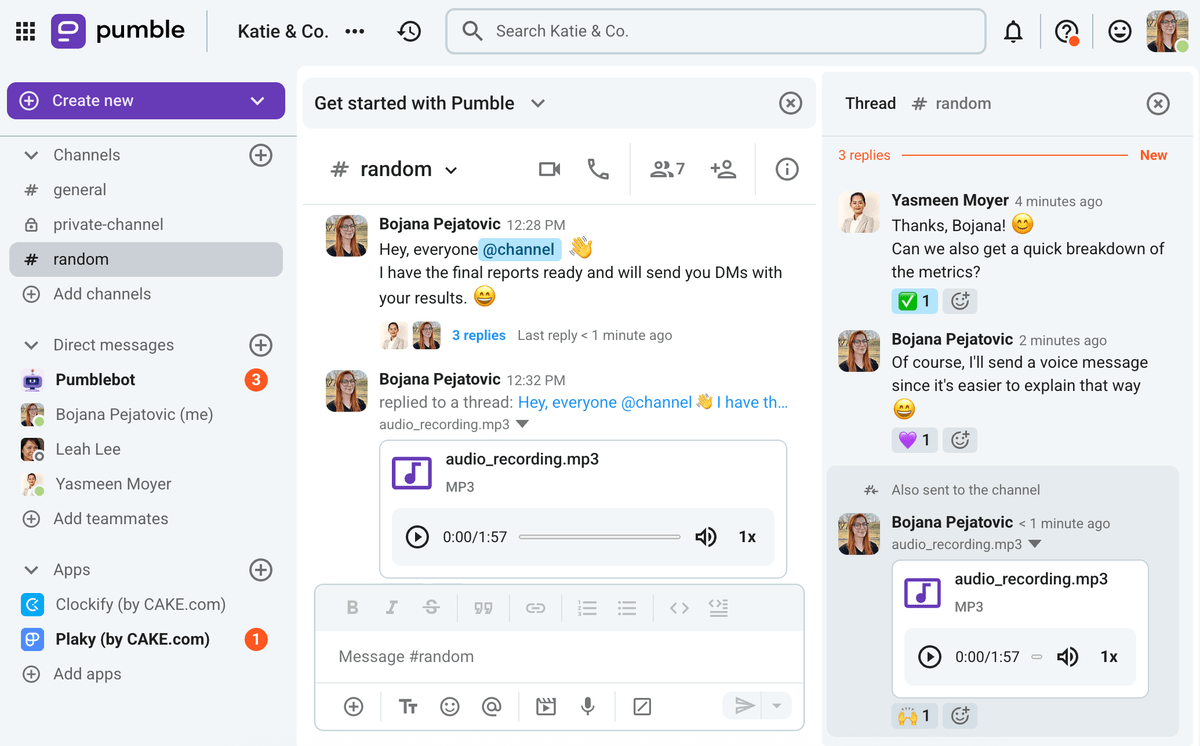
However, at the same time, Pumble also supports organized, asynchronous collaboration.
Pumble’s smart notifications allow you to create a schedule that works for you and allows you to organize your work day in any way you see fit. This leaves plenty of room for deep work and focus.
What’s more, Pumble also offers threads, a feature that helps streamline communication and cuts down on unnecessary notifications.
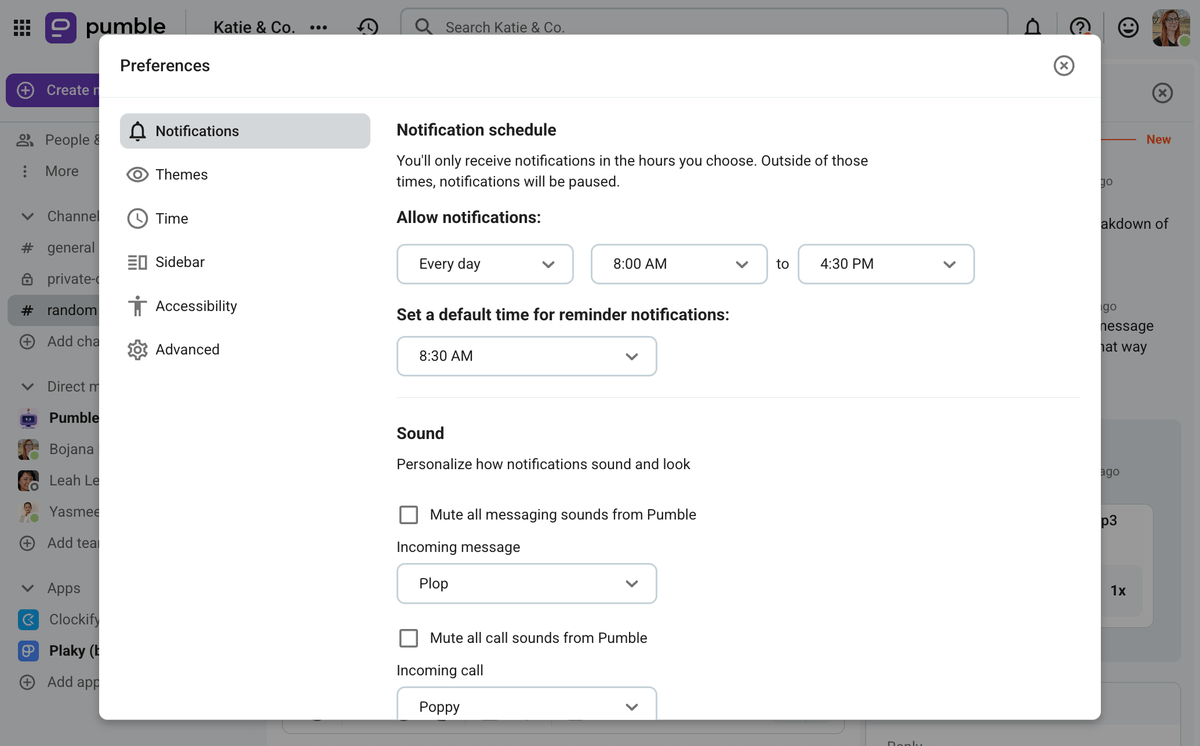
With a familiar, Slack-like interface that’s exceptionally user-friendly, and an organized, thread-based structure that’s reminiscent of Twist, Pumble really has it all.
And, most importantly, Pumble offers all of this for a much lower price — and even for free!
Both Slack and Twist use their free plans to hook users in. They give you a taste of their functionalities and make you pay for more.
Pumble, on the other hand, doesn’t do that. It offers unlimited users and unlimited messaging and file history, as well as its core functionalities, for free.
This gives you the freedom to build your digital HQ in it without the fear of losing vital information after 90 days (or a month).
And, if, after a while, you want to scale your team and upgrade the functionalities available to you, you can do it by subscribing to one of Pumble’s 3 paid plans.
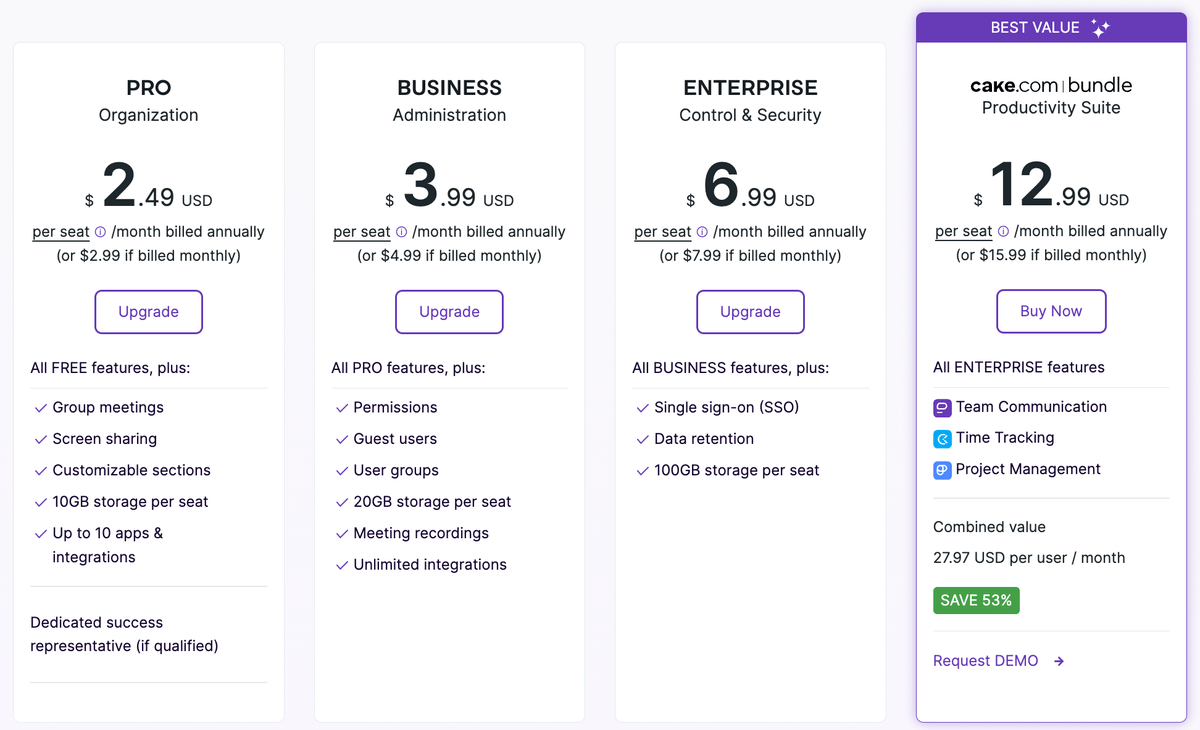
In a modern workplace, teams require both real-time and asynchronous communication for productive collaboration. So, pick an app that can do both — pick Pumble!



